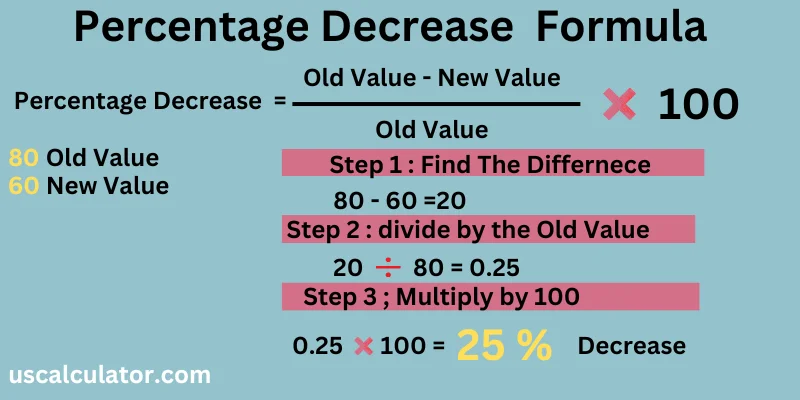Percentage Decrease Calculator
Need to track savings or measure a drop? Our Percentage Decrease Calculator delivers fast results! Enter original and new values to see the percentage fall instantly. Great for sale discounts, budget trimming, or academic work. Simple, free, and reliable—figure out reductions in seconds!
Share Calculator
Common Calculators | |
Table of Contents

Percentage decrease calculation formula
We have given the calculation formula of the percentage Decrease calculator in a picture above
The formula for calculating the percentage decrease is
Percentage Decrease = [(Original Value - New Value) / Original Value] × 100%
| Percentage Decrease = ( |
| ) × 100% |
Understand the Percentage Decrease Formula calculation method.
Here's what each part of the formula represents -
Original Value- This is the starting value before the decrease.
New Value- This is the ending value after the decrease.
These steps are also given in the picture above. Here are 3 Steps to Calculate Percentage Decrease.
1. Discover the contrast between unique and modern esteem. Subtract the modern esteem from the exceptional value.
2. Divide the distinction by the unique esteem - This gives you the relative decrease as a decimal.
3. Multiply by 100 and include a percent sign - This changes the decimal into a rate.
Examples of Calculating Percentage Decrease
Presently, we will get three cases of Rate Decrease
Example 1. Let us understand an example. New vs. Original Price: Suppose a shirt was initially priced at $100, but currently it is on sale for $80. So by what percent did the price decrease of the shirt?
The calculation is easy. Original price (unique cost): $100. New price (deal cost): $80. Follow the following steps: We calculate how much the price decreased. Difference = $100 (unique) - $80 (unused) = $20 price decreased. Now we will calculate the percentage. Relative decrease = $20 (decrease) / $100 (unique) = 0.2
Percentage decrease = 0.2 x 100% = 20%. So, the price of the shirt decreased by 20%
Example 2. Here, we will understand the second example. "Expense Reduction" Imagine your monthly costs were $3,200, but you adjusted some budgeting procedures and reduced them to $2,700. What will be your expense reduction rate here? First, we will calculate how much $ we reduced the expense. Original cost (unique cost): $3,200. New cost (unused cost): $2,700. Follow the steps below: Difference = $3,200 (unique) - $2,700 (modern) = $500 expense reduction. Now we will calculate the percent reduction we made. Relative reduction = $500 (reduction) / $3,200 (unique) = 0.15625. Percentage reduction = 0.15625 x 100% = 15.625% (rounded off to two decimal places). So, your monthly cost is reduced by 15.625%.
Example 3. Here we understand the third example.- Loss in Body Mass:
Suppose someone weighed 100 kg before starting a weight loss program, and now he weighs 85 kg. What will be the percentage loss in body mass? First, we will calculate the number of kgs of weight loss. Original value (original weight): 100 kg. New value (new weight): 85 kg. Follow the steps given below:
Difference = 100 kg (original) - 85 kg (new) = 15 kg weight loss. Now we will calculate the percentage loss.
Relative loss = 15 kg (loss) / 100 kg (original) = 0.15
Percentage loss = 0.15 x 100% = 15%
So, his body mass has lost 15% of its weight
Here, you are given three examples to calculate the percentage reduction. Now you must have understood the decrease in percentage well.
If you have any confusion or doubt, then double-check with our Percentage Decrease Calculator.